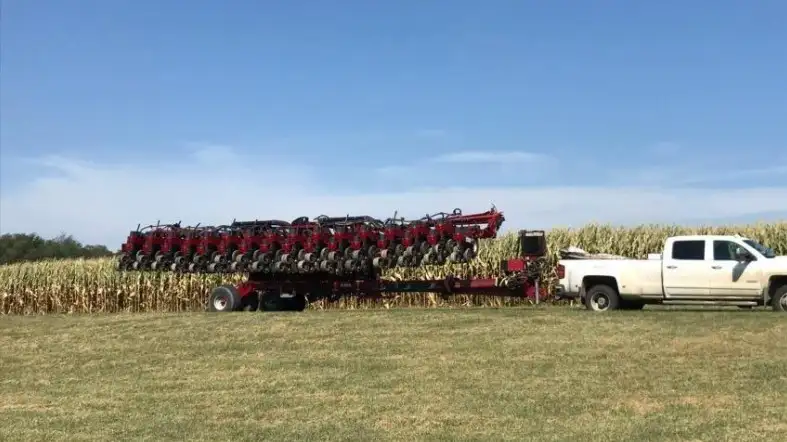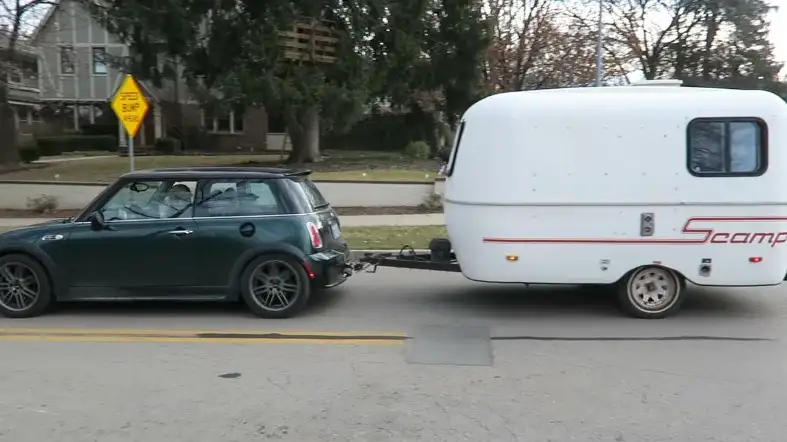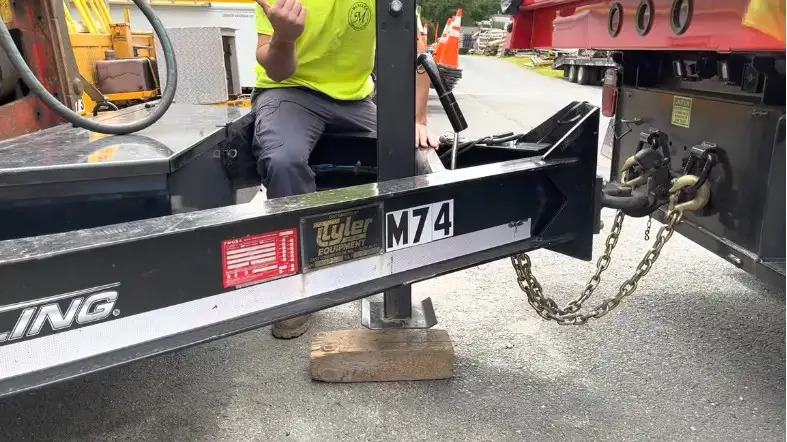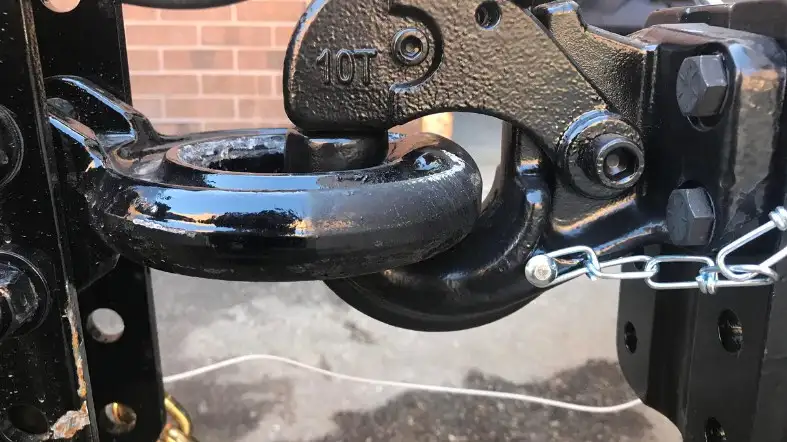Are you ready to hit the road and take your towing setup to the next level?
Look no further than the pintle hitch!
With its rugged design and reliable performance, the pintle hitch is a favorite among those who need a strong and secure connection for their towing needs.
Whether you’re hauling a heavy load or tackling tough terrain, the pintle hitch has you covered.
So why wait?
Get ready to experience the power and versatility of towing with the pintle hitch!
Towing with a Pintle Hitch
Towing with a pintle hitch involves the following steps:

1. Make sure that the towing vehicle and the trailer are compatible for towing with a pintle hitch.
The towing vehicle should have a pintle hitch mount, and the trailer should have a pintle hitch coupler.
2. Position the towing vehicle and the trailer so that the pintle hitch coupler on the trailer is aligned with the pintle hitch mount on the towing vehicle.
3. Secure the trailer to the towing vehicle by attaching the pintle hitch coupler to the pintle hitch mount.
This can typically be done by hand, but a lug wrench or a pin lock may be required to secure the coupler in place.
4. Connect the safety chains between the towing vehicle and the trailer.
The safety chains should be crossed under the hitch, and they should be tightened so that there is minimal slack.
5. Attach the electrical connectors between the towing vehicle and the trailer.
This will allow the trailer’s lights and brakes to be controlled by the towing vehicle.
6. Check that all of the connections are secure and that the trailer is properly aligned with the towing vehicle.
7. Begin towing the trailer by driving the towing vehicle.
Be sure to observe all applicable traffic laws and to use caution when towing a trailer.
How Much Can You Tow with a Pintle Hitch?
Generally, most pintle hitches are able to handle loads up to around 10,000-pound load capacity.

This makes them a versatile and reliable option for anyone who needs to move heavy equipment or tow large trailers, boats, or other vehicles.
Here is a general guide to the weight capacities of different pintle hitch sizes:
| Pintle Hitch Size | Maximum Weight Capacity |
|---|---|
| 1/4 inch | 2,000 lbs |
| 5/16 inch | 3,500 lbs |
| 3/8 inch | 5,000 lbs |
| 1/2 inch | 10,000 lbs |
| 5/8 inch | 15,000 lbs |
| 3/4 inch | 20,000 lbs |
Pros and Cons of a Pintle Hitch?
A pintle hitch has some pros and cons that are important to consider when deciding whether or not this type of hitch is right for your needs.
Below we will give some pros and cons of using a pintle hitch:
Pros:
1. The pintle hitch is extremely strong and durable, making it ideal for towing heavy or large loads.
2. Because the pintle hitch attaches directly to the trailer, there is very little movement or shake when pulling a load.
It helps keep your cargo securely in place.
3. In addition to being able to tow large loads, the pintle hitch can also handle a variety of different terrains and road conditions with ease.
Cons:
1. While the pintle hitch is strong and durable, it can be more difficult to attach and remove when compared to other types of towing equipment.
2. Because the pintle hitch is directly connected to the trailer, it can be more difficult to maneuver or control when compared to other types of hitches.
3. In some cases, the pintle hitch can be a bit noisy when in use, which may be an issue if you are frequently towing in residential or other quiet areas.
Overall, while there are some potential downsides to using a pintle hitch, it can be an excellent choice for anyone who needs to tow heavy or large loads on a regular basis.
Is a Pintle Hitches Better than a Ball Hitches?
Yes, a Pintle Hitch is often a better option than a ball hitch when it comes to towing heavy loads.

Unlike the ball hitch, which relies on the friction between the hitch and the ball to keep your load secure, the pintle hitch offers more stability and security due to its unique design.
The pintle hitch consists of two parts: a hook that attaches to your vehicle, and a ring or plate that secures the load.
This design allows for a more direct transfer of power from your vehicle to your towed load, helping you tow heavy loads with confidence.
Additionally, the pintle hitch is an ideal choice for off-road driving, as it offers excellent mobility and maneuverability even over rough terrain.
That’s why, if you need to tow heavy loads on a regular basis, a pintle hitch is the best choice for you.
How Much Tongue Weight Can A Pintle Hitch Hold?
A pintle hitch can weigh 12,000 pounds tongue weight, making it a great option for towing heavy loads or large vehicles.
It features a simple construction with a single point of attachment and is commonly used for trailers that require frequent movements like construction sites and military applications.
When using a pintle hitch, it’s important to ensure that you have the right amount of tongue weight on your vehicle.
Too much tongue weight can put too much strain on your towing system, while not enough tongue weight can make it difficult to control your vehicle and cause swaying or instability.
If you’re unsure about how much tongue weight is right for your pintle hitch, be sure to consult with a professional or read the instructions for your particular model.
With the right amount of tongue weight, your pintle hitch can help you tow large or heavy loads with ease and ensure a safe and stable driving experience.
What Happens When You Exceed Tongue Weight In a Pintle Hitch?

When towing a heavy load with a pintle hitch, it is important to ensure that you do not exceed the recommended tongue weight of your vehicle.
Exceeding this limit can put undue stress on your vehicle and increase the risk of damage or even accidents.
One common cause of exceeding tongue weight in pintle hitch towing is overloading your trailer or camper.
Make sure that you are only loading your vehicle with the maximum weight.
It can safely handle and take careful measurements of your tongue weight while loaded.
If you are still having trouble keeping within the recommended limits, consider making some adjustments to the way that you tow.
For example, you may want to try using a weight distribution system or trailer sway control device, which can help redistribute the load more evenly and reduce stress on your vehicle.
So be sure to take the necessary steps to stay within your limits, and enjoy a safe and worry-free towing experience.
Do You Need Safety Chains with a Pintle Hitch?
Yes, it is important to use safety chains when towing with a pintle hitch.
The pintle hitch is a type of trailer hitch commonly used for heavy-duty towing applications, such as hauling large equipment or trailers.
To help ensure the safety of your vehicle and others on the road, it is essential that you use safety chains whenever you tow with a pintle hitch.
These chains help to secure your trailer in case the pintle hitch becomes detached from your vehicle, preventing it from becoming a hazard on the road.
There are many different types of safety chains available for use with pintle hitches, including heavy-duty chain and cable assemblies as well as wire rope and cable assemblies.
When choosing the right safety chains for your needs, be sure to consider factors such as the weight of your trailer and the climate in which you will be driving, as these can affect how resistant the chains are to wear and tear.
When you’re planning to tow with a pintle hitch, make sure to always use safety chains to keep you, your vehicle, and others on the road safe.
FAQs About Towing with pintle hitch
Are Pintle Hitches Noisy?
No, pintle hitches are not typically noisy when towing.
But some noise is to be expected, especially when towing over rough surfaces or hitting bumps in the road.
Can You Flip A Pintle Hitch?
Yes, it is possible to flip a pintle hitch.
This can happen if the trailer becomes detached from your vehicle, or if there is excessive weight on the hitch that causes it to pivot.
Are Pintle Hitches Heavy?
Depending on the size and type of pintle hitch, they can be fairly heavy.
But most pintle hitches are designed to be durable and sturdy.
So they can typically withstand heavier loads than other types of trailer hitches.
Conclusion
Hope you know more about towing pintle hitches.
Whether you’re hauling heavy or light loads, make sure to always use safety chains when towing with a pintle hitch.
Take care to stay within the recommended tongue weight limits.
Also, consider the pros and cons of this type of hitch when deciding if it is the right choice for your towing needs.
With proper care and attention, you can safely enjoy all the benefits that pintle hitches have to offer.
